斯坦福卫生经济学教材(Health Economics)杰伊·巴塔查里亚《健康经济学》课程教学资源(PPT课件,英文版)Chapter 06 THE HOSPITAL INDUSTRY
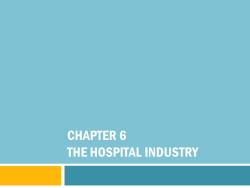
CHAPTER 6 THE HOSPITAL INDUSTRY
CHAPTER 6 THE HOSPITAL INDUSTRY
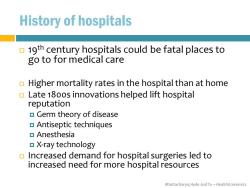
History of hospitals 1gth century hospitals could be fatal places to go to for medical care Higher mortality rates in the hospital than at home Late 18oos innovations helped lift hospital reputation Germ theory of disease Antiseptic techniques ▣Anesthesia X-ray technology Increased demand for hospital surgeries led to increased need for more hospital resources Bhattacharya,Hyde and Tu-HealthEconomics
Bhattacharya, Hyde and Tu – Health Economics History of hospitals 19th century hospitals could be fatal places to go to for medical care Higher mortality rates in the hospital than at home Late 1800s innovations helped lift hospital reputation Germ theory of disease Antiseptic techniques Anesthesia X-ray technology Increased demand for hospital surgeries led to increased need for more hospital resources

History of hospitals In 1946,the Hill-Burton Act increased the number of hospitals in the US Congress gave monies for building hospitals Any hospital receiving money had to provide free/low cost care to the poor Result:more hospitals and more hospital beds Bhattacharya,Hyde and Tu-HealthEconomics
Bhattacharya, Hyde and Tu – Health Economics History of hospitals In 1946, the Hill-Burton Act increased the number of hospitals in the US Congress gave monies for building hospitals Any hospital receiving money had to provide free/low cost care to the poor Result: more hospitals and more hospital beds
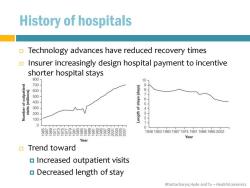
History of hospitals Technology advances have reduced recovery times Insurer increasingly design hospital payment to incentive shorter hospital stays 800 10 700 600 9 500 400 61 300 200 3 100 0 容5SS6S留B8BB餐33 194619531960196719741981198819952002 Year Year Trend toward Increased outpatient visits Decreased length of stay Bhattacharya,Hyde and Tu-HealthEconomics
Bhattacharya, Hyde and Tu – Health Economics History of hospitals Technology advances have reduced recovery times Insurer increasingly design hospital payment to incentive shorter hospital stays Trend toward Increased outpatient visits Decreased length of stay

THE RELATIONSHIP BETWEEN HOSPITALS AND PHYSICIANS Ch 6:The Hospital Industry
Ch 6: The Hospital Industry THE RELATIONSHIP BETWEEN HOSPITALS AND PHYSICIANS
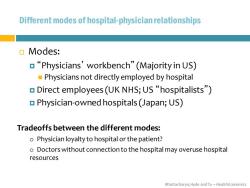
Different modes of hospital-physician relationships ▣Modes: a“Physicians'workbench”(Majority in US) Physicians not directly employed by hospital ▣Direct employees(UK NHS;US“hospitalists”) Physician-owned hospitals(Japan;US) Tradeoffs between the different modes: o Physician loyalty to hospital or the patient? o Doctors without connection to the hospital may overuse hospital resources Bhattacharya,Hyde and Tu-HealthEconomics
Bhattacharya, Hyde and Tu – Health Economics Different modes of hospital-physician relationships Modes: “Physicians’workbench” (Majority in US) ◼ Physicians not directly employed by hospital Direct employees (UK NHS; US “hospitalists”) Physician-owned hospitals (Japan; US) Tradeoffs between the different modes: o Physician loyalty to hospital or the patient? o Doctors without connection to the hospital may overuse hospital resources
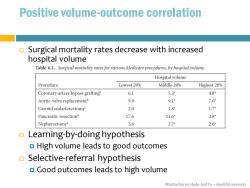
Positive volume-outcome correlation Surgical mortality rates decrease with increased hospital volume Table 6.1.Surgical mortality rates for various Medicare procedures,by hospital volume. Hospital volume Procedure Lowest 20% Middle 20% Highest 20% Coronary-artery bypass grafting" 6.1 5.3* 4.8 Aortic-valve replacement 9.9 9.1* 7.6 Carotid endarterectomy 2.0 1.8* 1.7* Pancreatic resectiond 17.6 11.6* 3.8* Nepherectomy 3.6 2.7* 2.6 Learning-by-doing hypothesis High volume leads to good outcomes Selective-referral hypothesis Good outcomes leads to high volume Bhattacharya,Hyde and Tu-HealthEconomics
Bhattacharya, Hyde and Tu – Health Economics Surgical mortality rates decrease with increased hospital volume Learning-by-doing hypothesis High volume leads to good outcomes Selective-referral hypothesis Good outcomes leads to high volume Positive volume-outcome correlation
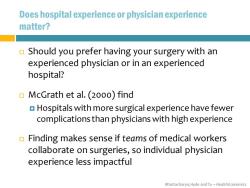
Does hospital experience or physician experience matter? Should you prefer having your surgery with an experienced physician or in an experienced hospital? McGrath et al.(2000)find Hospitals with more surgical experience have fewer complications than physicians with high experience Finding makes sense if teams of medical workers collaborate on surgeries,so individual physician experience less impactful Bhattacharya,Hyde and Tu-HealthEconomics
Bhattacharya, Hyde and Tu – Health Economics Does hospital experience or physician experience matter? Should you prefer having your surgery with an experienced physician or in an experienced hospital? McGrath et al. (2000) find Hospitals with more surgical experience have fewer complications than physicians with high experience Finding makes sense if teams of medical workers collaborate on surgeries, so individual physician experience less impactful
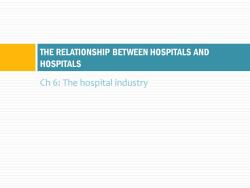
THE RELATIONSHIP BETWEEN HOSPITALS AND HOSPITALS Ch 6:The hospital industry
Ch 6: The hospital industry THE RELATIONSHIP BETWEEN HOSPITALS AND HOSPITALS
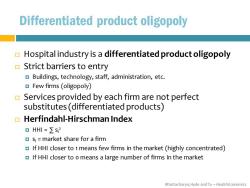
Differentiated product oligopoly Hospital industry is a differentiated product oligopoly Strict barriers to entry Buildings,technology,staff,administration,etc. Few firms(oligopoly) Services provided by each firm are not perfect substitutes(differentiated products) Herfindahl-Hirschman Index 口HHI=∑s si=market share for a firm If HHI closer to 1 means few firms in the market (highly concentrated) If HHI closer to o means a large number of firms in the market Bhattacharya,Hyde and Tu-HealthEconomics
Bhattacharya, Hyde and Tu – Health Economics Differentiated product oligopoly Hospital industry is a differentiated product oligopoly Strict barriers to entry Buildings, technology, staff, administration, etc. Few firms (oligopoly) Services provided by each firm are not perfect substitutes (differentiated products) Herfindahl-Hirschman Index HHI = ∑ si 2 si = market share for a firm If HHI closer to 1 means few firms in the market (highly concentrated) If HHI closer to 0 means a large number of firms in the market
按次数下载不扣除下载券;
注册用户24小时内重复下载只扣除一次;
顺序:VIP每日次数-->可用次数-->下载券;
- 斯坦福卫生经济学教材(Health Economics)杰伊·巴塔查里亚《健康经济学》课程教学资源(PPT课件,英文版)Chapter 05 THE PHYSICIAN LABOR MARKET.ppt
- 斯坦福卫生经济学教材(Health Economics)杰伊·巴塔查里亚《健康经济学》课程教学资源(PPT课件,英文版)Chapter 04 SOCIOECONOMIC DISPARITIES IN HEALTH.ppt
- 斯坦福卫生经济学教材(Health Economics)杰伊·巴塔查里亚《健康经济学》课程教学资源(PPT课件,英文版)Chapter 03 CHAPTER 3 DEMAND FOR HEALTH:THE GROSSMAN MODEL.ppt
- 斯坦福卫生经济学教材(Health Economics)杰伊·巴塔查里亚《健康经济学》课程教学资源(PPT课件,英文版)Chapter 24 TIME INCONSISTENCY AND HEALTH.ppt
- 斯坦福卫生经济学教材(Health Economics)杰伊·巴塔查里亚《健康经济学》课程教学资源(PPT课件,英文版)Chapter 23 PROSPECT THEORY.ppt
- 斯坦福卫生经济学教材(Health Economics)杰伊·巴塔查里亚《健康经济学》课程教学资源(PPT课件,英文版)Chapter 22 OBESITY.ppt
- 斯坦福卫生经济学教材(Health Economics)杰伊·巴塔查里亚《健康经济学》课程教学资源(PPT课件,英文版)Chapter 21 ECONOMIC EPIDEMIOLOGY.ppt
- 斯坦福卫生经济学教材(Health Economics)杰伊·巴塔查里亚《健康经济学》课程教学资源(PPT课件,英文版)Chapter 20 THE ECONOMICS OF HEALTH EXTERNALITIES.ppt
- 斯坦福卫生经济学教材(Health Economics)杰伊·巴塔查里亚《健康经济学》课程教学资源(PPT课件,英文版)Chapter 02 DEMAND FOR HEALTH CARE.ppt
- 斯坦福卫生经济学教材(Health Economics)杰伊·巴塔查里亚《健康经济学》课程教学资源(PPT课件,英文版)Chapter 19 POPULATION AGING AND THE FUTURE OF HEALTH POLICY.ppt
- 斯坦福卫生经济学教材(Health Economics)杰伊·巴塔查里亚《健康经济学》课程教学资源(PPT课件,英文版)Chapter 18 THE AMERICAN MODEL.ppt
- 斯坦福卫生经济学教材(Health Economics)杰伊·巴塔查里亚《健康经济学》课程教学资源(PPT课件,英文版)Chapter 17 THE BISMARCK MODEL - SOCIAL HEALTH INSURANCE.ppt
- 斯坦福卫生经济学教材(Health Economics)杰伊·巴塔查里亚《健康经济学》课程教学资源(PPT课件,英文版)Chapter 16 THE BEVERIDGE MODEL - NATIONALIZED HEALTH CARE.ppt
- 斯坦福卫生经济学教材(Health Economics)杰伊·巴塔查里亚《健康经济学》课程教学资源(PPT课件,英文版)Chapter 15 THE HEALTH POLICY CONUNDRUM.ppt
- 斯坦福卫生经济学教材(Health Economics)杰伊·巴塔查里亚《健康经济学》课程教学资源(PPT课件,英文版)Chapter 14 HEALTH TECHNOLOGY ASSESSMENT.ppt
- 斯坦福卫生经济学教材(Health Economics)杰伊·巴塔查里亚《健康经济学》课程教学资源(PPT课件,英文版)Chapter 13 TECHNOLOGY AND THE PRICE OF HEALTH CARE.ppt
- 斯坦福卫生经济学教材(Health Economics)杰伊·巴塔查里亚《健康经济学》课程教学资源(PPT课件,英文版)Chapter 12 PHARMACEUTICALS AND THE ECONOMICS OF INNOVATION.ppt
- 斯坦福卫生经济学教材(Health Economics)杰伊·巴塔查里亚《健康经济学》课程教学资源(PPT课件,英文版)Chapter 11 MORAL HAZARD.ppt
- 斯坦福卫生经济学教材(Health Economics)杰伊·巴塔查里亚《健康经济学》课程教学资源(PPT课件,英文版)Chapter 10 ADVERSE SELECTION IN REAL MARKETS.ppt
- 斯坦福卫生经济学教材(Health Economics)杰伊·巴塔查里亚《健康经济学》课程教学资源(PPT课件,英文版)Chapter 01 WHY HEALTH ECONOMICS?.ppt
- 斯坦福卫生经济学教材(Health Economics)杰伊·巴塔查里亚《健康经济学》课程教学资源(PPT课件,英文版)Chapter 07 DEMAND FOR INSURANCE.ppt
- 斯坦福卫生经济学教材(Health Economics)杰伊·巴塔查里亚《健康经济学》课程教学资源(PPT课件,英文版)Chapter 08 ADVERSE SELECTION - AKERLOF’S MARKET FOR LEMONS.ppt
- 斯坦福卫生经济学教材(Health Economics)杰伊·巴塔查里亚《健康经济学》课程教学资源(PPT课件,英文版)Chapter 09 ADVERSE SELECTION - THE ROTHSCHILD-STIGLITZ MODEL.ppt
- 兰州交通大学:《微观经济学》课程教学资源(教案大纲)教学大纲 Microeconomics(负责人:李新文).pdf
- 兰州交通大学:《微观经济学》课程教学资源(教案大纲)微观经济学授课教案(打印版).pdf
- 兰州交通大学:《微观经济学》课程教学资源(案例分析)微观经济学教学案例(打印版).pdf
- 《微观经济学》课程教学资源(书籍文献)西方经济学名著选读.pdf
- 兰州交通大学:《微观经济学》课程教学资源(试卷习题)微观经济学各章习题库及参考答案(打印版,共十一章).pdf
- 兰州交通大学:《微观经济学》课程教学资源(试卷习题)微观经济学试题(A卷)试卷(打印版).pdf
- 兰州交通大学:《微观经济学》课程教学资源(试卷习题)微观经济学试卷(A卷)答案(打印版).pdf
- 兰州交通大学:《微观经济学》课程教学资源(课件讲稿,打印版)第一章 导论(负责人:李新文).pdf
- 兰州交通大学:《微观经济学》课程教学资源(课件讲稿,打印版)第二章 需求曲线和供给曲线以及均衡价格(供给需求和均衡价格).pdf
- 兰州交通大学:《微观经济学》课程教学资源(课件讲稿,打印版)第三章 效用论.pdf
- 兰州交通大学:《微观经济学》课程教学资源(课件讲稿,打印版)第四章 生产论.pdf
- 兰州交通大学:《微观经济学》课程教学资源(课件讲稿,打印版)第五章 成本论.pdf
- 兰州交通大学:《微观经济学》课程教学资源(课件讲稿,打印版)第七章 不完全竞争的市场.pdf
- 兰州交通大学:《微观经济学》课程教学资源(课件讲稿,打印版)第八章 生产要素价格的决定.pdf
- 兰州交通大学:《微观经济学》课程教学资源(课件讲稿,打印版)第九章 一般均衡论和福利经济学.pdf
- 兰州交通大学:《微观经济学》课程教学资源(课件讲稿,打印版)第十一章 市场失灵和微观经济政策.pdf
- 兰州交通大学:《微观经济学》课程教学资源(课件讲稿,打印版)第十章 博弈论初步.pdf
